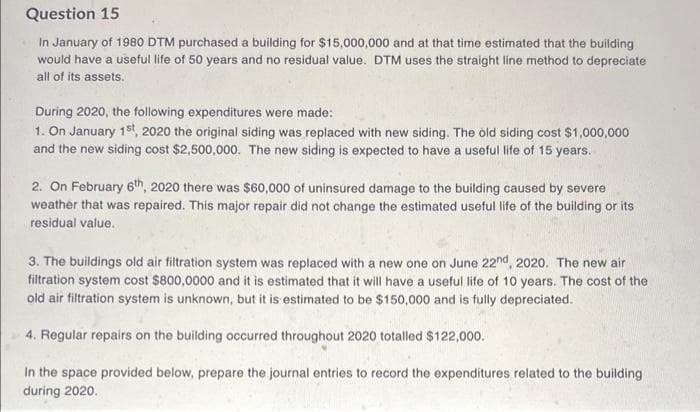In January of 1980 DTM purchased a building for $15,000,000 and at that time estimated that the building would have a useful life of 50 years and no residual value. DTM uses the straight line method to depreciate all of its assets. During 2020, the following expenditures were made: 1. On January 1st, 2020 the original siding was replaced with new siding. The old siding cost $1,000,000 and the new siding cost $2,500,000. The new siding is expected to have a useful life of 15 years. 2. On February 6th, 2020 there was $60,000 of uninsured damage to the building caused by severe weather that was repaired. This major repair did not change the estimated useful life of the building or its residual value. 3. The buildings old air filtration system was replaced with a new one on June 22nd, 2020. The new air filtration system cost $800,0000 and it is estimated that it will have a useful life of 10 years. The cost of the old air filtration system is unknown, but it is estimated to be $150,000 and is fully depreciated. 4. Regular repairs on the building occurred throughout 2020 totalled $122,000. In the space provided below, prepare the journal entries to record the expenditures related to the building during 2020.
In January of 1980 DTM purchased a building for $15,000,000 and at that time estimated that the building would have a useful life of 50 years and no residual value. DTM uses the straight line method to depreciate all of its assets. During 2020, the following expenditures were made: 1. On January 1st, 2020 the original siding was replaced with new siding. The old siding cost $1,000,000 and the new siding cost $2,500,000. The new siding is expected to have a useful life of 15 years. 2. On February 6th, 2020 there was $60,000 of uninsured damage to the building caused by severe weather that was repaired. This major repair did not change the estimated useful life of the building or its residual value. 3. The buildings old air filtration system was replaced with a new one on June 22nd, 2020. The new air filtration system cost $800,0000 and it is estimated that it will have a useful life of 10 years. The cost of the old air filtration system is unknown, but it is estimated to be $150,000 and is fully depreciated. 4. Regular repairs on the building occurred throughout 2020 totalled $122,000. In the space provided below, prepare the journal entries to record the expenditures related to the building during 2020.
Financial Accounting: The Impact on Decision Makers
10th Edition
ISBN:9781305654174
Author:Gary A. Porter, Curtis L. Norton
Publisher:Gary A. Porter, Curtis L. Norton
Chapter8: Operating Assets: Property, Plant, And Equipment, And Intangibles
Section: Chapter Questions
Problem 8.8MCP
Related questions
Question

Transcribed Image Text:Question 15
In January of 1980 DTM purchased a building for $15,000,000 and at that time estimated that the building
would have a useful life of 50 years and no residual value. DTM uses the straight line method to depreciate
all of its assets.
During 2020, the following expenditures were made:
1. On January 1st, 2020 the original siding was replaced with new siding. The old siding cost $1,000,000
and the new siding cost $2,500,000. The new siding is expected to have a useful life of 15 years.
2. On February 6th, 2020 there was $60,000 of uninsured damage to the building caused by severe
weather that was repaired. This major repair did not change the estimated useful life of the building or its
residual value.
3. The buildings old air filtration system was replaced with a new one on June 22nd, 2020. The new air
filtration system cost $800,0000 and it is estimated that it will have a useful life of 10 years. The cost of the
old air filtration system is unknown, but it is estimated to be $150,000 and is fully depreciated.
4. Regular repairs on the building occurred throughout 2020 totalled $122,000.
In the space provided below, prepare the journal entries to record the expenditures related to the building
during 2020.
Expert Solution
This question has been solved!
Explore an expertly crafted, step-by-step solution for a thorough understanding of key concepts.
Step by step
Solved in 3 steps

Knowledge Booster
Learn more about
Need a deep-dive on the concept behind this application? Look no further. Learn more about this topic, accounting and related others by exploring similar questions and additional content below.Recommended textbooks for you

Financial Accounting: The Impact on Decision Make…
Accounting
ISBN:
9781305654174
Author:
Gary A. Porter, Curtis L. Norton
Publisher:
Cengage Learning

Cornerstones of Financial Accounting
Accounting
ISBN:
9781337690881
Author:
Jay Rich, Jeff Jones
Publisher:
Cengage Learning

Intermediate Accounting: Reporting And Analysis
Accounting
ISBN:
9781337788281
Author:
James M. Wahlen, Jefferson P. Jones, Donald Pagach
Publisher:
Cengage Learning

Financial Accounting: The Impact on Decision Make…
Accounting
ISBN:
9781305654174
Author:
Gary A. Porter, Curtis L. Norton
Publisher:
Cengage Learning

Cornerstones of Financial Accounting
Accounting
ISBN:
9781337690881
Author:
Jay Rich, Jeff Jones
Publisher:
Cengage Learning

Intermediate Accounting: Reporting And Analysis
Accounting
ISBN:
9781337788281
Author:
James M. Wahlen, Jefferson P. Jones, Donald Pagach
Publisher:
Cengage Learning



Individual Income Taxes
Accounting
ISBN:
9780357109731
Author:
Hoffman
Publisher:
CENGAGE LEARNING - CONSIGNMENT